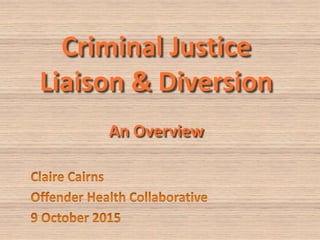Report
Share

Recommended
Recommended
A Stop and Search presentation delivered by IPCC Commissioner Jennifer Izekor

A Stop and Search presentation delivered by IPCC Commissioner Jennifer IzekorThe Independent Police Complaints Commission
Nick Prendergat - The International Perspective on Youth Mental Health Services

Nick Prendergat - The International Perspective on Youth Mental Health ServicesYouth Mental Health Network
More Related Content
Similar to 9 October Presentation
A Stop and Search presentation delivered by IPCC Commissioner Jennifer Izekor

A Stop and Search presentation delivered by IPCC Commissioner Jennifer IzekorThe Independent Police Complaints Commission
Nick Prendergat - The International Perspective on Youth Mental Health Services

Nick Prendergat - The International Perspective on Youth Mental Health ServicesYouth Mental Health Network
Similar to 9 October Presentation (20)
Reducing reoffending through multi-agency partnerships

Reducing reoffending through multi-agency partnerships
Care Quality Commission: Driving improvement in the investigation of deaths

Care Quality Commission: Driving improvement in the investigation of deaths
A Stop and Search presentation delivered by IPCC Commissioner Jennifer Izekor

A Stop and Search presentation delivered by IPCC Commissioner Jennifer Izekor
Early Intervention: Improving Access to Mental Health by 2020 [Presentations]![Early Intervention: Improving Access to Mental Health by 2020 [Presentations]](data:image/gif;base64,R0lGODlhAQABAIAAAAAAAP///yH5BAEAAAAALAAAAAABAAEAAAIBRAA7)
![Early Intervention: Improving Access to Mental Health by 2020 [Presentations]](data:image/gif;base64,R0lGODlhAQABAIAAAAAAAP///yH5BAEAAAAALAAAAAABAAEAAAIBRAA7)
Early Intervention: Improving Access to Mental Health by 2020 [Presentations]
Youth in Conflict_Melissa Sharer and Marcy Levy_10.17.13

Youth in Conflict_Melissa Sharer and Marcy Levy_10.17.13
Diversion First: Progress-to-Date, and a Look to the Future: Fall 2016

Diversion First: Progress-to-Date, and a Look to the Future: Fall 2016
Nick Prendergat - The International Perspective on Youth Mental Health Services

Nick Prendergat - The International Perspective on Youth Mental Health Services
Estimating the costs of Child Sexual Abuse in the UK

Estimating the costs of Child Sexual Abuse in the UK
9 October Presentation
- 1. Criminal Justice Liaison & Diversion An Overview
- 3. Overview • A process to identify, screen and assess individuals who have vulnerabilities who come into contact with the criminal justice system • Criminal Justice diversion is not new (Reed report 1992). Liaison broadens this out (Bradley report 2009) • National Programme of L&D commenced April 2014 (10 trial sites) and a further wave of trial sites started in April 2015, of which South Yorkshire is one • Business case for national roll-out of L&D with NHS England as lead commissioner
- 4. Why is Liaison & Diversion Needed? Vulnerability Substance Misuse Alcohol Misuse Offending Imprisonment Social Isolation
- 5. Commissioning & Support for L&D NHS England Service Providers OHC
- 7. National Operating Model for Liaison & Diversion • A service for all ages (children and adults) • A service covering key points of the criminal justice system (police stations and courts) with an emphasis on early identification • A 24/7 service • Catering for all vulnerabilities (beyond just mental health) • Core team and extended team
- 9. Liaison and Diversion Stages of Operation Identification Criminal justice agencies, such as police and courts, are trained to identify signs that an offender may have a learning disability, mental health issue, drug and substance misuse or other vulnerability. Screening Specialist L&D practitioners with range of skills (eg, learning disability expertise, children and young people) carry out screening to identify need and if they should be referred onwards for further assessment, treatment or further support. Assessment L&D services can also complete or refer for further assessment including specialist assessment. Referral Offenders needing further support and treatment will be referred into appropriate services, such as learning disability services.
- 11. Liaison and Diversion Points of Operation • Community settings, including schools and restorative justice, where police engage with children and young people • Police custody suites • Police stations (or other prosecuting authorities) where voluntary attendance occurs • Magistrates’ courts • Youth courts and referral order panels • The Crown Court • Probation to assist with the production of PSR • Youth offending teams (YOTs)